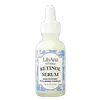What's inside
What's inside
 Key Ingredients
Key Ingredients

 Benefits
Benefits

 Concerns
Concerns

 Ingredients Side-by-side
Ingredients Side-by-side

Aloe Barbadensis Leaf Juice
Skin ConditioningGlycerin
HumectantHamamelis Virginiana Water
AstringentSimmondsia Chinensis Seed Oil
EmollientHelianthus Annuus Seed Oil
EmollientJojoba Esters
EmollientSambucus Nigra Fruit Extract
AstringentArachidyl Alcohol
EmollientTribehenin
EmollientTocopheryl Acetate
AntioxidantGlyceryl Stearate
EmollientNiacinamide
SmoothingCopernicia Cerifera Wax
Behenyl Alcohol
EmollientArachidyl Glucoside
EmulsifyingHyaluronic Acid
HumectantAcacia Senegal Gum
MaskingXanthan Gum
EmulsifyingRetinol
Skin ConditioningChamomilla Recutita Flower Extract
MaskingCucumis Sativus Fruit Extract
EmollientAllantoin
Skin ConditioningAloe Barbadensis Leaf Juice, Glycerin, Hamamelis Virginiana Water, Simmondsia Chinensis Seed Oil, Helianthus Annuus Seed Oil, Jojoba Esters, Sambucus Nigra Fruit Extract, Arachidyl Alcohol, Tribehenin, Tocopheryl Acetate, Glyceryl Stearate, Niacinamide, Copernicia Cerifera Wax, Behenyl Alcohol, Arachidyl Glucoside, Hyaluronic Acid, Acacia Senegal Gum, Xanthan Gum, Retinol, Chamomilla Recutita Flower Extract, Cucumis Sativus Fruit Extract, Allantoin
Water
Skin ConditioningGlycerin
HumectantPropanediol
SolventButylene Glycol
HumectantGlycereth-26
HumectantRetinyl Palmitate 2.36%
Skin ConditioningHelianthus Annuus Seed Oil
Emollient1,2-Hexanediol
Skin ConditioningCaprylic/Capric Triglyceride
MaskingDiphenyl Dimethicone
EmollientOctyldodeceth-16
EmulsifyingHydroxyethyl Acrylate/Sodium Acryloyldimethyl Taurate Copolymer
Emulsion StabilisingC12-14 Alketh-12
EmulsifyingHippophae Rhamnoides Oil
EmollientSodium Polyacrylate
AbsorbentAcrylates/C10-30 Alkyl Acrylate Crosspolymer
Emulsion StabilisingEthylhexylglycerin
Skin ConditioningTromethamine
BufferingPolysorbate 20
EmulsifyingRetinol
Skin ConditioningAdenosine
Skin ConditioningTocopherol
AntioxidantSorbitan Isostearate
EmulsifyingMalva Sylvestris Flower Extract
Skin ConditioningCoptis Japonica Root Extract
Skin ConditioningCentella Asiatica Extract
CleansingEthylhexyl Olivate
Skin ConditioningHydrogenated Lecithin
EmulsifyingBHT
AntioxidantSodium Acrylates Copolymer
Polygonum Cuspidatum Root Extract
AntioxidantScutellaria Baicalensis Root Extract
AstringentPolyglyceryl-4 Oleate
EmulsifyingGlycyrrhiza Glabra Root Extract
BleachingCamellia Sinensis Leaf Extract
AntimicrobialBHA
AntioxidantRosmarinus Officinalis Leaf Extract
AntimicrobialChamomilla Recutita Flower Extract
MaskingLactococcus Ferment Lysate
Skin ConditioningAscorbic Acid
AntioxidantCollagen Extract
Skin ConditioningWater, Glycerin, Propanediol, Butylene Glycol, Glycereth-26, Retinyl Palmitate 2.36%, Helianthus Annuus Seed Oil, 1,2-Hexanediol, Caprylic/Capric Triglyceride, Diphenyl Dimethicone, Octyldodeceth-16, Hydroxyethyl Acrylate/Sodium Acryloyldimethyl Taurate Copolymer, C12-14 Alketh-12, Hippophae Rhamnoides Oil, Sodium Polyacrylate, Acrylates/C10-30 Alkyl Acrylate Crosspolymer, Ethylhexylglycerin, Tromethamine, Polysorbate 20, Retinol, Adenosine, Tocopherol, Sorbitan Isostearate, Malva Sylvestris Flower Extract, Coptis Japonica Root Extract, Centella Asiatica Extract, Ethylhexyl Olivate, Hydrogenated Lecithin, BHT, Sodium Acrylates Copolymer, Polygonum Cuspidatum Root Extract, Scutellaria Baicalensis Root Extract, Polyglyceryl-4 Oleate, Glycyrrhiza Glabra Root Extract, Camellia Sinensis Leaf Extract, BHA, Rosmarinus Officinalis Leaf Extract, Chamomilla Recutita Flower Extract, Lactococcus Ferment Lysate, Ascorbic Acid, Collagen Extract
Ingredients Explained
These ingredients are found in both products.
Ingredients higher up in an ingredient list are typically present in a larger amount.
Chamomilla Recutita Flower Extract comes from the Chamomile flower.
Chamomile is rich in antioxidants and has anti-inflammatory properties. Several compounds found in chamomile help with soothing, such as bisbolol.
Antioxidant components in chamomile make it an effective ingredient to help slow the signs of aging. Antioxidants help fight free-radical molecules, or molecules that may damage your skin.
Essential oils from chamomile have been found to improve wound healing due to its antimicrobial properties.
Ancient Greeks and Egyptians used Chamomile to treat skin redness and dryness. Chamomile has also been used to help treat stomach issues.
Learn more about Chamomilla Recutita Flower ExtractGlycerin is already naturally found in your skin. It helps moisturize and protect your skin.
A study from 2016 found glycerin to be more effective as a humectant than AHAs and hyaluronic acid.
As a humectant, it helps the skin stay hydrated by pulling moisture to your skin. The low molecular weight of glycerin allows it to pull moisture into the deeper layers of your skin.
Hydrated skin improves your skin barrier; Your skin barrier helps protect against irritants and bacteria.
Glycerin has also been found to have antimicrobial and antiviral properties. Due to these properties, glycerin is often used in wound and burn treatments.
In cosmetics, glycerin is usually derived from plants such as soybean or palm. However, it can also be sourced from animals, such as tallow or animal fat.
This ingredient is organic, colorless, odorless, and non-toxic.
Glycerin is the name for this ingredient in American English. British English uses Glycerol/Glycerine.
Learn more about GlycerinHelianthus Annuus Seed Oil is the oil derived from the seeds of a Sunflower. Sunflower seed oil is non-fragrant. It is an emollient, meaning it helps to soften the skin.
Sunflower seed oil contains many fatty acids. The fatty acids found in sunflower seeds include (from highest amount to least): linoleic acid, myristic acid, palmitic acid, stearic acid, arachidic acid, oleic acid, and linolenic acid.
These fatty acids help the skin create ceramides. Ceramides play a role in repairing the skin barrier.
Helianthus Annuus Seed Oil helps moisturize the skin. This in turn helps the skin look more rejuvenated and smoother.
Sunflowers are rich in vitamin E.
Historians believe Indigenous cultures of North America domesticated sunflowers before corn. Thus they relied on sunflower oil for a variety of uses. One such use is moisturizing skin and hair.
Sunflower seed oil may not be fungal acne safe. We recommend speaking with a professional if you have any concerns.
Learn more about Helianthus Annuus Seed OilRetinol is a gold-standard ingredient for anti-aging. It is a form of Vitamin A and belongs to the class of retinoids that also includes tretinoin.
Why is retinol famous?
It has the most scientific studies backing up its skin benefits out of all the non-prescription ingredients.
Retinol is proven to:
This is why retinol is effective at removing wrinkles, fading dark spots, treating acne, and reducing the appearance of pores.
Studies show retinol is less effective when exposed to UV. Be sure to look for appropriate packaging to keep your retinol potent (similar to Vitamin C).
Using retinol or any retinoids will increase sun-sensitivity in the first few months. Though studies show retinoids increase your skin's natural SPF with continuous use, it is best to always wear sunscreen and sun-protection.
We recommend speaking with a medical professional about using this ingredient during pregnancy.
Retinol may cause irritation in some people, so be sure to patch test. Experts recommend 'ramping up' retinol use: start using this ingredient once a week and work up to using it daily.
Read about Tretinoin
Learn more about Retinol